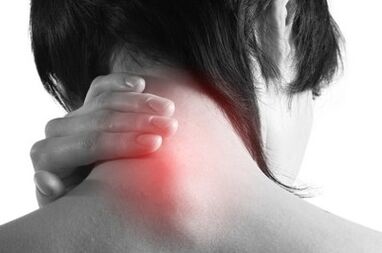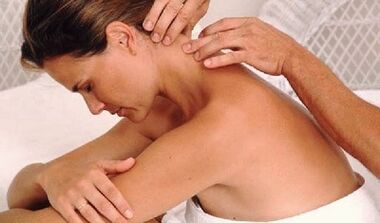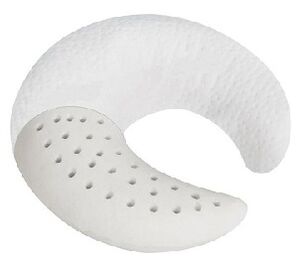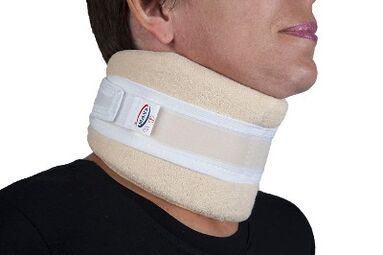
Osteochondrosis is a defeat of intervertebral discs of a dystrophic degenerative nature, and the cervical region is the most vulnerable part of the spine, which has an anatomically different structure from another close to the vertebrae and the low muscular corset.Therefore, even with small additional loads on the neck, the vertebrae of the vertebrae can occur, causing blood vessels and nerves.
And since the vertebral arteries involved in the blood supply to the brain cross the holes in the transverse processes of the vertebrae in this department, the impressions of the vertebrae in this department or tightening the holes with invaded osteofites are loaded with very serious consequences.
What is this?
Osteochondrosis in the cervical region is a progressive polyetiological disease that manifests itself by the degeneration of intervertebral discs and the dystrophy of the ligament apparatus of the spine.
Causes
The main causes and prerequisites for the occurrence of osteochondrosis of the cervical vertebra are:
- Spine of faith, scoliosis.
- Stress, nervous stresses negatively affect the general condition of the body, can cause cervical osteochondosis.
- Transferred infectious diseases often become the deep cause.
- The erroneous and uncomfortable position of the body during sleep (for example, an uncomfortable pillow).
- Congenital problems or presence of hereditary diseases of the cervical column.
- Posture violation in young people and adolescence.
- Excess weight, obesity of different degrees.Trost kilos increase the load on the vertebrae and the discs, which leads to degenerative processes.
- Back injury, which may have taken place in childhood or adolescence.
- Violation of metabolic processes.
- Physical work, which can cause column diseases in different departments.
- Cheap lifestyle, sitting sitting, inappropriate performance of all exercises.
For the successful treatment of osteochondrosis in the cervical region, it is first necessary to establish the cause of the occurrence, the prerequisites which have caused its development and eliminate them.Until recently, the disease has only been found in people aged 45.Now young people are submitted to him, the age group is 18 to 25 years old.
Characteristics of the cervical region
Consider how the cervical region differs from the rest of the spine, and that in the process of development of osteochondrosis, it serves as a prerequisite for the development of these syndromes.
- In the cervical region, important nodes (nodes) of the autonomic nervous system are located.
- In the transverse processes of the vertebrae, there are holes that form a channel through which the vertebral artery passes which provides oxygen and nutrients the brain, the cerebellum, the hearing organs, as well as the vertebral nerve.These are the prerequisites for the frequent pliers of the artery and the nerve.
- The cervical column is the most mobile.It is characterized by all types of movements entirely.These are prerequisites for frequent offenses and subluxations.
- The intervertebral holes of the three lower vertebrae are not round, but a triangular shape.These are prerequisites for violation of nerve roots with bone growths that form with osteochondrosis.
- Intervertebral discs are located between vertebral bodies that are not everywhere.In front of them, there are protruding edges of the vertebrae, which are interconnected by joints.These are the prerequisites for the emergence of the subluxation of the joints.
Development steps
The degree of osteochondosis is determined by the clinical picture and the patient complaints.The concept of degree should not be confused with the stages of osteochondosis.The steps will be discussed below.
- The first degree.The clinical manifestations are minimal, the patient can complain about pain in the cervical column of low intensity, he can intensify when the head is turned.During a physical examination, slight tension of the neck muscles can be detected.
- The second degree.The patient is concerned about pain in the cervical column, his intensity is much greater, there can be radiation in the shoulder, in the hand.This occurs due to a decrease in the height of the intervertebral disc and the violation of the roots of the nerves.The pain intensifies when tilted and turning with the head.The patient may note a decrease in performance, weakness, headache.
- The third degree.The symptoms of cervical osteochondosis are improved, the pain becomes constant with the radiation in the arm or shoulder.Numbness or weakness in the muscles of the hand appears, because the hernias of the intervertebral discs are formed.Concerned about weakness, dizziness.On examination, the limitation of mobility in the cervical column is revealed, the pain on the palpation of the cervical column.
- The fourth degree.There is a complete destruction of the intervertebral disc and its replacement by the connective tissue.Dizzying intensifies, noise in the ears appears, a violation of coordination, since the vertebral artery is involved in the process that feeds the cerebellum and the occipital fraction of the brain.
Symptoms
The severity of the symptoms of cervical osteochondosis depends on the degree of destruction of the structures of the vertebrae.Symptoms are aggravated by the growth of bone tissue with the formation of osteophytes, root syndrome (root pain when it has pinched the nerve), intervertebral hernia (discs of the disc in the vertebral canal).
The first signs of the disease are periodic headaches in the neck, pain in the neck, a crunch and clicks in the vertebrae during the turn of the head, sometimes a slight tingling.Over time, the symptoms develop and the intensity of the pain intensifies.
Pain syndrome is the main manifestation of osteochondrosis.The pain in the neck is stupid permanent or sharp with bastards under the back of the back of the head when filming the head.The entire cervical compartment or the projection zone can affect a modified vertebra, as well as a collar, in the shoulder, to the spatula, to the heart zone.The irradiation of the pain in the lower jaw, the teeth, the arm, the ear, the area of the eyes is not excluded.The muscles of the neck and shoulders are tense, painful to palpation.It is difficult to raise your hand on the side of the defeat - immediately there is a blow in the shoulder or the neck.The restriction of the movements of the head due to pain often occurs in the morning after sleep in an uncomfortable position.
The disease leads to pressing the roots of the peripheral nerves (Roing syndrome) and causes pain along these nerves.It is possible to numb hands or fingers, a violation of the sensitivity of certain skin areas innervated by a pinched nerve.
For certain characteristic symptoms, we can assume which vertebrae are affected:
- C1 - altered sensitivity in the occipital region;
- C2 - Pain in the occipital and parietal areas;
- C3-a decreased sensitivity and pain in the half of the neck where the vertebral nerve is violated, a violation of the sensitivity of language, a disability of the word due to a loss of control over the language;
- C4 - The sensitivity and pain altered in the shoulder region, a decrease in the tone of the muscles of the head and neck, respiratory disorders, pain in the liver and the heart are possible;
- C5 - Pain and altered sensitivity in the outer surface of the shoulder;
- C6-Pain spreading from the neck to the omoplade, forearms, external surface of the shoulder, radial surface of the forearm to the thumb of the hand;
- C7 - Pain spreading from the neck to the shoulder blade, the rear surface of the shoulder, the forearm to the fingers II - IV from the hand, the altered sensitivity in this area.
- C8 - The pain and altered sensitivity spread from the neck to the shoulder, the forearm on the little finger.
Cervical osteochondosis is always accompanied by a headache.Strong and persistent pain intensifies during the neck or sudden movements.Some patients complain about the severity of their heads.The compression of the vertebral artery leads to dizziness, nausea.There is a noise, which rings in the ears, flickering blackheads in front of the eyes.The deterioration of brain traffic causes a gradual decrease in hearing and vision, a numbness of the language, a change in taste sensations.
Clicks or cracking with a neck almost always accompany cervical osteochondosis, observed in each patient.A crunch appears during a lively turn of the head or its back.
Syndromes caused by cervical osteochondosis
Symptoms of cervical osteochondosis are formed in certain groups called syndromes.Their presence and their severity can indicate a pathology in the cervical column with an updated location.
A group of syndromes frequently found:
- Vegetative-diaiabolic syndrome.SUBLUXUS The first vertebra of cervical departure with a displacement can lead to the development of vegeto-vacation dystonia.This is not a certain diagnosis of VVD because it has no pronounced symptoms.There may be neurological signs, symptoms of alteration of brain blood flow, intracranial pressure, muscle cramps.Consequently, the patient's complaints come down to dizziness, a decrease in visual acuity, a loss of consciousness, headache, nausea.
- Irritative reflex.Burning and acute pain on the back of the head and neck, sometimes with the return to the chest and shoulder, which occurs when changing the position of the head and neck, sneezing and a pointed turn of the head.
- Koreshka.Otherwise, called cervical radiculitis, it combines the symptoms associated with the offense of the nerve roots of the cervical vertebrae.The "goosebumps" in the affected area, the tingling in the fingers, the forearms, the pallor of the skin, spreads to certain fingers are characteristic.
- Heart.Almost the same image with angina often continues an inappropriate diagnosis and treatment.The syndrome appears due to the irritation of the diaphragmatic nerve receptors, partially captivating the pericardium and a large chest muscle.Thus, cramps in the region of the heart are more reflexes, as a review of the irritation of the cervical nerves.
- Vail artery syndrome.It develops directly both with the compression of the artery itself and with the irritation of the sympathetic nervous plexus, which is located around it.The pain in this pathology is burning or pulsating in the occipital region with a propagation to whiskey, tutorial arches, crows.It arises on both sides.Patients generally associate aggravation with a condition after sleep in a non-violeological installation, travel in transport, walking.With pronounced symptoms, hearing loss, stunning, noise in the ears, nausea, vomiting, loss of consciousness and increasing blood pressure are possible.
Diagnosis
Like any diagnosis in medicine, the diagnosis of osteochondrosis is established on the basis of patient complaints, the anamnesis of the disease, the clinical examination and the auxiliary research methods.The X -ray of the cervical column in direct and lateral projections is carried out, if necessary in special positions (with an open mouth).At the same time, experts are interested in the height of the intervertebral discs, the presence of osteofites.
Modern research methods, IAMR and CT research is used, which makes it possible to check the diagnosis most precisely.In addition to the methods listed of additional research, consultations with related specialists (cardiologist, ophthalmologist, neurosurgeon) may be necessary and the examination of the neurologist is simply vital.The neurologist is engaged in the treatment of osteochondrosis, so after examining the patient, he will prescribe the minimum examination necessary for his discretion.
How to treat osteochondrosis of the cervical column?
The complex treatment of cervical osteochondosis can include the following traditional and non -traditional methods: drug treatment, massage, acupression, manual therapy, physiotherapy, acupuncture, homeopathy, folk remedies, etc.
The main treatment regime for osteochondrosis is the same for all locations of this disease:
- You should first eliminate pain syndrome.
- Then edema will be deleted.
- At this stage, it is necessary to normalize blood circulation.
- Reinforcement of the muscle corset.
- Improved nutrition and regeneration of fabrics.
The list of drugs and drugs for the treatment of cervical osteochondosis at home is very wide:
- Anti-inflammatory (steroid).These are hormonal drugs that relieve inflammatory phenomena and thus eliminate pain;
- Analgesics (non -steroidal drugs that relieve pain).Usually, they are prescribed in the form of tablets or capsules.It should be remembered that most of these drugs cause irritation of the mucous membrane of the digestive tract;
- Musorelaxing are drugs that relax muscle tone.They are used in surgery and orthopedics as auxiliary remedies for stopping pain.Such drugs are administered by parenting, and therefore always under the supervision of a doctor.There is an in-depth list of contraindications;
- Chondroprotectors are drugs containing substances that replace the components of cartilage.To obtain a persistent positive effect, such drugs must be taken for a very long time;
- Nails and gels for external use.It is the most affordable group of drugs in the home atmosphere.They are divided into inflammation, warming and analgesic.These funds are often announced.With cervical osteochondosis, all ointments are not effective, moreover, due to accessibility, they are sometimes used unreasonably and without taking into account the characteristics of pathogenesis.
- Vitamins.With osteochondrosis, vitamins are prescribed which have a beneficial effect on the peripheral nervous system and improve conductivity.Vitamins soluble in water: B1, B6, B12, Soluble Vitamins in fat: A, C, D, E. In recent years, combined drugs containing analgesics and vitamin components more often.

Only the team of good specialists, which includes a neurologist, a physiotherapist, a masseur, a surgeon, a vertebrist, can choose the most appropriate therapy.
Medical physical education
The LFK for cervical osteochondosis should be carried out outside of acute exacerbation.The greatest efficiency of this technique during the recovery period.During the implementation of the complex, there should be no discomfort and pain!
- Exercise number 1. Lie on your belly, rest your hands on the floor, lift your head and a torso, your back should be straight.Stay in this position for 1 to 2 minutes.Slowly flow to the ground.Repeat 2-3 times.
- Exercise number 2. Lie on your belly, stretch your arms along the body, turn your head to the left, try touching the floor with your ear, then turn your head to the right.Repeat 6 to 7 times in each direction.
- Exercise number 3. In the sitting position, lean forward and try to touch your chest with your head, then exhale, lean back and throw your head.Repeat 10 to 15 times.
- Exercise number 4. When you sit, put your palms on your forehead, put pressure on your palms on your forehead and your forehead on your palm.Continue this exercise for 30 seconds.Repeat 2-3 times.
- Exercise number 5. Slowly turn your head first in one direction, then in the other direction.10 rotations in each direction.Make sure there are no dizziness.When it appears, the exercise stops.
Therapeutic massage
The massage can be done at home, but very carefully so as not to cause exacerbation and not to harm the patient.The patient must take the position to go to bed, put his forehead on his hands and stretch his chin to the chest.In this case, the neck muscles should be completely relaxed.
- Caressing.It is necessary to start the massage with these movements: to caress the collar area in the direction of the lymph towards the nodes superraclinking and axillary.Then, flat and crest lines are used.
- Pressing.To make the compression, the masseur puts his hand on the neck (the index and the thumb must be together) and moves in the spine.Compression can also be carried out by the edge of the palm to the shoulder joints.
- Trituration.The friction is carried out to reheat the muscles, relax them and improve blood flow in this area.The massage must start from the base of the skull, making circular fingers and simple movements.You can also make sawing movements by defining your palms in parallel on the ribs.
- Kneading.The neck must be petri in circular movements.
- Vibration.The massage is completed by caress and vibration, which is carried out using concussion and cerebral vascular accidents.

Massage is necessary to strengthen muscle tone and relieve pain.Depending on the osteochondrosis stage, the massage technique is selected.However, when making neck massage, experts use all classic massage techniques: rub, petrir, etc.In cases where the patient does not hurt on one side, the massage begins in the healthy part of the neck, gradually moving towards this part of the necklace area where pain occurs.
Manual therapy
Manual therapy helps to deal with acute and chronic pain, also increases the volume of movements and improves posture well.The main manual therapy techniques for osteochondrosis of the cervical column:
- Relaxing and segmental massage.It is used to warm the muscles and relieve tension.
- Mobilization.Impacts to restore joint functions by traction.
- Handling.A strong impulse of the patient's pathological areas.The procedure is accompanied by a characteristic crunch (the return of the articulation to a normal position).
Manual specialized practice therapy must perfectly have these techniques.Otherwise, any error can cause injuries.

Orthopedic pillows
Orthopedic pillows to sleep are an effective means of prevention.In many cases, osteochondrosis is aggravated due to the additional transmission of the cervical artery and nerve roots during sleep on an uncomfortable pillow.The orthopedic product provides a uniform horizontal position of a person during sleep and, thus, guarantees the supply of physiologically complete blood to the brain.
When choosing a pillow, the individual anatomical characteristics of a person must be taken into account and they must be correlated with the volume and the characteristics of the filling.A properly selected pillow provides tangible advantages to the patient with osteochondrosis of the cervical column.
Physiotherapy
Physiotherapeutic procedures for osteochondrosis in the cervical region:
- Electrophoresis.It should be used using pain relievers (anesthetics), which are introduced under the skin by electronic impulses.
- Ultrasound.It affects metabolic processes in the tissues in the cervical region, due to which swelling is removed, the pain goes.
- Magnetotherapy.A safe treatment technique, which consists in the effect of damaged cells of a low -frequency magnetic field.This gives an analgesic effect, acts as an anti-inflammatory agent.
- Laser therapy.Improves blood circulation in the damage area, relieves the swelling of the tissues, the pain.
Physiotherapeutic procedures favorably affect discs and cervical osteochondosis vertebrae.In combination with drugs, combined treatment helps get rid of the symptoms of the disease.Procedures are carried out in a hospital or offices specializing in clinics.Before starting the course, it is necessary to consult a doctor, determine the duration of physiotherapy, types.It is strictly forbidden to pass it during exacerbation.

Shanza necklace
The Shantsa necklace is a soft and practical device, fixing behind a Velcro and used for cervical osteochondosis.But not for treatment, but for temporary relaxation and elimination of fatigue.It cannot be worn without removing, otherwise the neck muscles will stop working and soon atrophy.If a Chantza necklace is selected correctly, the patient feels comfortable and safe.
A necklace is strictly selected in a pharmacy or orthopedic store.Better in the store, because the people who work there, as a rule, know their business well and their characterization of goods and, therefore, can help in each particular case.
Folk remedies
If the pain of osteochondrosis of the spine becomes unbearable and regular, you will accept everything, if only to stop it, and here a traditional complex treatment will successfully complete the folk methods.
- Insist the root of the celery (5 gr. By 1 liter of boiling water) for 4 hours, drink a tablespoon before each meal;
- Honey Compress, for which we take 2 teaspoons.Honey and 1 mother of tablets.We heat the components in a double boiler, stall on the fabric and apply to the cervical region, that is to say the neck, at night;
- In acute pain, the hell growing in the country helps me.Its leaf is simply mine, I compose with boiling water, I cool it a little, I put it around my neck and hide it with a thin scarf in the evening - in the morning, you can already live and work;
- We emphasize chamomile flowers in vegetable oil for two days, after heating to a boil (30 ml of oil is necessary for 30 grams of plant), rubbing in painful areas;
- The honey compress, also helps, for that, the root harvest should be rubbed and mixed with honey in the same quantity, attach to the endolori neck at night, use it regularly, at least once a week.
Prevention
As usual, appropriate prevention will help avoid osteochondrosis in the cervical region, but, of course, all physical exercises should be used regularly, otherwise there will not be many advantages of "periodic" classes.
It remains to remember the simple rules:
- Eat more products with a large amount of calcium and magnesium.These are fish, peas, legumes, nuts, cheese, green vegetables, but sugar, flour, smoked, acute, it is preferable to abstain.
- Regularly practical of sport, in particular swimming, aquaerobics, also to prevent osteochondrosis, gymnastics for stretching and flexibility of the vertebrae is suitable, which can be practiced at home.
- When you sit at least a few times a day, perform a special exercise set.
- Choose a good orthopedic mattress and a pillow, perfect for the neck, supporting the head in a dream in the right anatomical position (yes, your favorite huge pillows with problems with the spine will not pass!).
If you already have such a diagnosis, the patient must save his spine, namely:
- To be very cautious with lifting and weight transport, it is better to go to the store twice as shooting unbearable bags in both hands, to incredibly prove the neck and the shoulder flow;
- Do not refuse to cool, avoid drafts and cold air of the air conditioner (some like to cool with a hot day, becoming their backs to the fan);
- When you tilt the body forward - Remember osteochondrosis;
- Avoid local muscle overheating, which can occur among lovers of an excessively hot bath;
- Do not forget to periodically break the monitor, to modify the position of the body, to not sit for hours, or even days;
- Give rest to the neck, for which it is necessary to buy a collar of Chantis;
- If possible, if the condition of the cardiovascular system allows it, steamed in the bath.
In conclusion, I would like to say that the child who threatens osteochondrosis (the father and the mother already have it) and an adult who has acquired the disease in the life process, must simply take preventive measures so as not to become disabled and not be on the operation table, because this operation is quite complicated and requires long -term rehabilitation.In addition, this is not always possible, because there are inoperable cases, it is therefore preferable to protect health with a younger, while the discs are intact and that unnecessary growths do not press blood vessels.


















